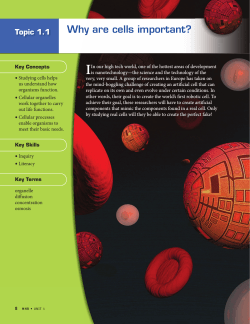
Single Chain Mean Field Technique for Simulation of Complex Molecular Systems (
Single Chain Mean Field Technique for Simulation of Complex Molecular Systems Sergey Pogodin† (msupsg@yandex.ru) and Vladimir Baulin†,‡ (vladimir.baulin@urv.cat) † ‡ Universitat Rovira i Virgili, Departament d’Enginyeria Química, Tarragona, Spain Institució Catalana de Recerca i Estudis Avançats, Barcelona, Spain Our Mission: - Why SCMF? - What is the SCMF? Single Chain Mean Field (SCMF) theory is a powerful tool for investigation of equilibrium behavior of complex molecular systems. It provides detailed microscopic information and gives direct access to the free energy of soft matter systems which is hard to obtain with others theoretical methods, such as Molecular Dynamics or Monte-Carlo simulation. However, the limiting factor preventing the SCMF theory from a wide use is the technical complexity in realization of reliable and efficient SCMF simulation code and a lack of standard simulation packages. In order to overcome these problems, we are developing fast and flexible SCMF program, which can be directly applied for the investigation of broad spectrum of complex molecular systems. Our 5 reasons to develop SCMF + + + + + 1. Develop fast and flexible SCMF simulation code suitable for a broad scientific use 2. Apply it for the investigation of relevant molecular systems’ behavior It gives direct access to the free energy and other equilibrium properties of soft matter systems It is extremely flexible, thus allowing for numerous applications to wide range of molecular systems It can be coupled with other simulations methods, proviing them with equilibrium initial states of the system Unlike the Monte-Carlo simulation method, it allows for direct parallelization of calculations It is challenging to develop the new method wich is not widely used due to technical complexity of realization SCMF theory uses mean-field approach which finds directly the minimums of the free energy for the system. We use the following three approximations Conformational states of different molecules are assumed to be Intermolecular interactions uncorrelated are approximated via interaction of single molecules with the mean-field concentrations The solvent is treated implicitly of others molecules and the incompressibility condition is applied in each point of the system This allows to separate the free-energy on entropy, intra- and intermolecular parts - How does the SCMF work? The current version of our SCMF simulation code is written in C++ with the use of OpenMP parallelization protocol. It is already suitable for performing real calculations, although it still have numerous restrictions and simplifications. So, we continue our work towards creation of complete SCMF package with flexible modular structure, easy to use, modificate and expand. Scheme of the SCMF program work flow Particular coarse-grained model for the molecules in the system Input of simulation parameters Properties of the simulation box (size, geometry, boundary conditions, ets.) Parameters, controlling the actual flow of the simulation process Potentials for intra- and inter- molecular interactions and derive a set of equations which determine the equilibrium distributions of the system’s compounds by minimizing the freeenergy. The average concentrations and the volumes occupied by the molecule’s units in each point are the averages of corresponding single-molecule quantities over the single-molecule probability functions ρ. The single-molecule probability functions ρ, in its turn, are the known combinations of average concentrations and the occupied volume distributions and others single-molecule properties, which could be calculated. Thus, generating sufficient sampling of single-molecule conformational spaces and solving the SCMF equations we are able to obtain with a reasonable accuracy data concerning the equilibrium behavior of multimolecular system. Generation of representative single-molecule conformational sampling for every kind of molecules presented in the system Potentials created by the molecules in different points of the simulation box Solving the SCMF equations Equilibrium distributions of the sistem compounds Data concerning bias of the generated sampling Calculation of auxiliary properties related to conformations in the samplings Distribution of the molecules’ beads inside the simulation box Solving the equations for different numbers of the molecules in the simulation box Coordinates of the beads for every conformation in the sampling Tracing multiple solutions, corresponding to the equilibrium and meta-stable states of the system Sorting and posttreatment of computed data Data output Free-energy values for the found solutions Mean field snapshots revealing the system behavior in the most representable way - What are we using the SCMF for? Simulation of Phospholipid Membrane 1 Piercing of the Membrane with a Nanotube 2 Micellization of Pluronic® surfactants Three models of dimyristoylphosphatidylcholine (DMPC) phospholipid molecule at different coarse-grained levels (44-, 10- and 3beads) were developed. Their parameters were fitted to reproduce the real properties of DMPC membranes: – Density profile of the membrane bilayer; – Average interfacial area per lipid (60 Å2); – Compressibility modulus (260 dyn/cm). Simulation of the DMPC membrane piercing by a carbon nanotube was carried out. Three diameters of the nanotube (1.00, 2.43, 4.86 nm.) corresponds to tipical sizes of the single-walled nanotubes. The membrane was simulated within the 3-beads model of lipid molecule and the level of the nanotube-membrane affinity was varied in vast region, changing the tube’s behavior from hydrophilic to strongly hydrophobic. Our measurements of the energy barriers created by the membrane of the nanotube penetration allowed us to conclude that the nanotubes are not able to spontaneously cross the membrane just by thermal motion without application of additional external force. The mean field snapshots (a set of most probable conformations) show the molecular details of piercing of the nanotube into lipid layer and the details of the bilayer rearrangements around the nanotube with the variation of the nanotube hydrophobicity. This work is devoted to creation of the unified coarse-grained models for Pluronic surfactants, (water soluble tri-block copolymers PEO-PPO-PEO). Due to the fact that different Pluronics differ only in their blocks length, the unified coarse-grained model of their chemical structure could be formulated. Interactions between the beads and the solvent, assumed to be the same for different Pluronics, are to be fitted to represent experimentally measured values of the surfactants’ critical micellization concentrations. Chemical structure of the DMPC phospholipid (a), shown against its 44-, 10- and 3- beads representations, (b), (c) and (d). Red and blue beads are hydrophobic and hydrophilic, correspondingly. Orange beads for the model (b) have completely the same properties as the red ones. Free energy plot for the 3-beads DMPC model. Red and green curves correspond to solution with one and two bilayers formed in the simulation box. In the last case both of the layers are slightly compressed, which results in the energy difference. The inset shows zoomed area of the red curve minimum. Coarse-grained representation of L64, P65, P84 and P85 Pluronic molecules. Micelle comprising of 100 L64 molecules. Summary Working prototype of the SCMF simulation package was developed and used for calculations of real systems. Mean field snapshot showing partial insertion of 2.43 nm. diameter hydrophobic nanotube inside the DMPC bilayer (part of the layer is not shown in order to simplify the picture). Energy barriers for perpendicular penetration of the nanotube with diameter 2.43 nm. inside the DMPC membrane. Different curves corresponds to different levels of the nanotube’s hydrophobicity. It was proved the ability of the method to simulate phospholipid membranes at various levels of coarse graining and reproduce the experimentaly relevant membrane properties. The method can be used for precise calculations of equilibrium free energy of insertion of nano-objects into lipid layers. This was used to study the process of the carbon nanotube translocation through the lipid membrane in order to show that spontaneous translocation of carbon nanotubes through the membranes is not possible. Perspectives Further developing of the SCMF software up to its public release. Design of hydrophobic/hydrophilic patterns on the nanotube surface, indicating the ways to lower the energy barrier for their translocation through the phospholipid membrane. Comparison of equilibrium DMPC membrane structure, obtained with three different levels of coarse-graining (a), and the membrane's density profiles (b), (c), (d) for 44-, 10- and 3- beads models, correspondingly. Red and blue lines on the profiles represents density of the hydrophobic and hydrophilic beads, while the black curves shows overall distribution of the lipids. References: [1]. Sergey Pogodin and Vladimir Baulin, Soft Matter, 2010, DOI: 10.1039/b927437e [2]. Sergey Pogodin and Vladimir Baulin, to be published Rearrangement of the DMPC bilayer around the nanotube with diameter 2.43 nm. during its perpendicular insertion. Snapshots represent the densities of the hydrophobic (red) and hydrophilic (blue) beads in the cross-section of the simulation box, taken through the symmetry axis of the nanotube. The tube’s hydrophobicity is increasing from the left to right, while the insertion depth is increasing from top to bottom. Study of insertion of peptides and proteins into phospholipid layers
© Copyright 2025

















